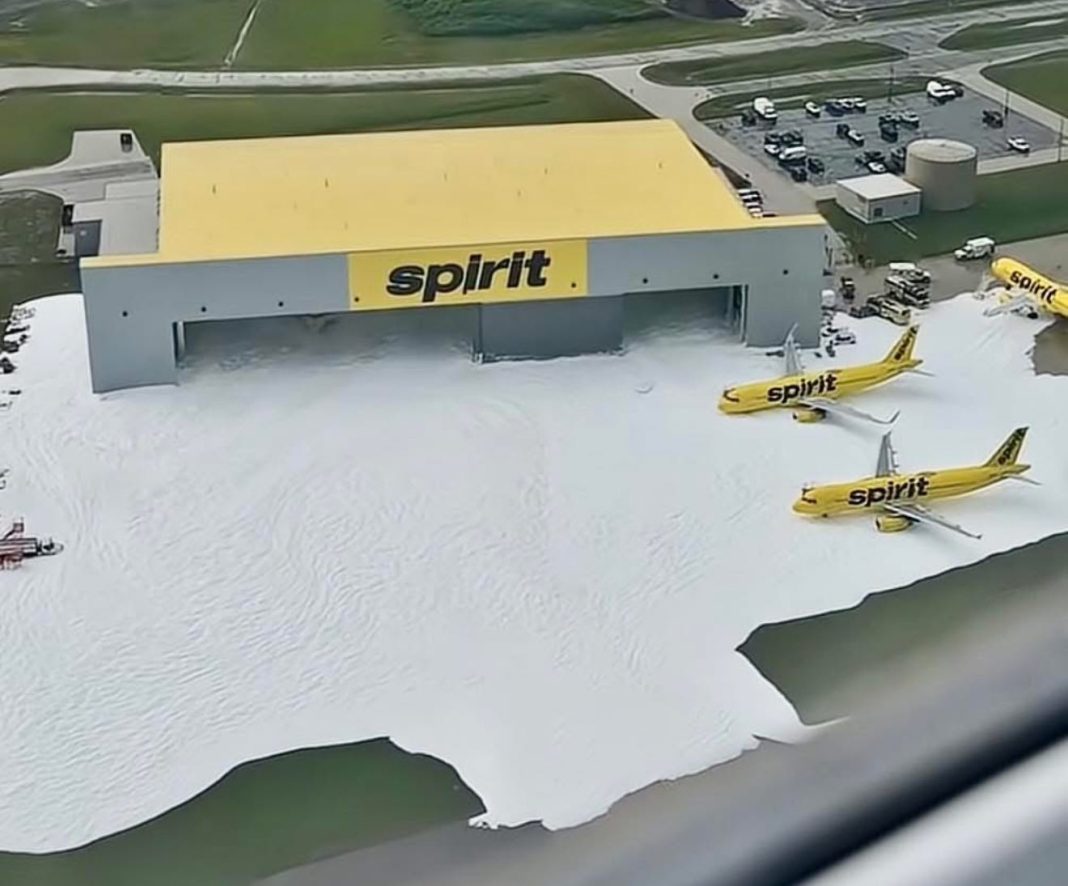[ad_1]
There was a Spirit Airlines foam party in Detroit on Independence Day, and we weren’t even invited.
A malfunctioning fire suppression system turned a routine evening at Detroit Metropolitan Wayne County Airport (DTW) into a frothy spectacle, flooding a maintenance hangar and its surroundings with corrosive foam. This was undoubtedly one July 4th celebration Spirit Airlines didn’t plan for, although we’re sure there were fireworks in CEO Dave Davis’ office that night.
Cloudy with a Chance of Foam

On the evening of 4 July 2025, a thunderstorm rolled through Detroit, and it seems Mother Nature had a mischievous streak. Around 1700 local time, a lightning strike is believed to have triggered the fire suppression system at one of Spirit Airlines’ primary maintenance facilities at DTW.
Instead of dousing flames as intended, the system unleashed a torrent of foam, blanketing the hangar and spilling onto the tarmac. It is unclear whether the 126,840-square-foot facility’s hangar door was open throughout the debacle or if Spirit Airlines personnel opened it to let the foam spill out.
First responders, unaware that there was no fire, rushed to the scene, ready to battle a blaze, only to find no flames—just a sea of Spirit Airlines foam engulfing everything in sight. The scene was less “Top Gun” and more “Ghostbusters” meets a bubble bath gone wrong.
Foam’s Corrosive Conundrums

Fire suppression foam is a lifesaver in aviation, designed to smother fuel-based fires, cool hot surfaces, and prevent reignition. It is composed of water, foam concentrate, and air, which combine to form a thick, flame-choking blanket.
The foam is corrosive and can damage aircraft engines, avionics, wiring, metal, and even cabin interiors. Older formulations, like PFAS-based foams, can degrade materials and contaminate the environment, making cleanup a race against time.
While a common practice in the early days of aviation, the use of foam in aviation, particularly to coat a runway before an emergency landing, has largely disappeared in recent decades. This article explains why.
Five Spirit aircraft–two inside the hangar (an Airbus A320 and an A321) and three parked outside–were caught in the foamstorm. A fourth Airbus on the ramp escaped unscathed.
Following the incident, Spirit Airlines issued a statement, claiming that operations would not be affected:
“On July 4, the fire suppression system at our DTW maintenance facility was inadvertently activated, which we believe was caused by lightning nearby. There was no fire, and no injuries were reported. Two aircraft parked inside the facility and one aircraft parked outside the facility were removed from service for inspection by our maintenance team. We have engaged a contractor to assist with cleanup efforts, and we thank first responders for their quick response and assistance. There is no impact to our flight operations.”
Spirit Airlines
Whether that’s true or not remains to be seen. However, the removal of three aircraft from service is significant. The airline operates a 195-aircraft all-Airbus fleet and is already facing operational constraints due to Pratt & Whitney engine issues, compounded by the busy summer travel season. The foam’s corrosive properties could lead to extended downtime for inspections and repairs, as it risks damaging critical components and creating environmental concerns. The carrier has not indicated a potential dollar amount in damages, but it is likely to be significant.
Cleaning Up the Bubbly Mess

By 5 July, first responders and cleanup crews were hard at work, battling the Spirit Airlines Foam Flood of ‘25 to minimize damage. The foam’s ability to seep into sensitive components like engines and avionics means every minute counts.
It is worth noting that this incident is not unique to Spirit. In 2020, American Airlines experienced a similar mishap at Chicago O’Hare International Airport (ORD), where two Boeing 787s were coated in foam due to an accidental fire suppression system activation. Other airlines have faced comparable sudsy sagas, too, proving that hangar foam parties are an occupational hazard in aviation.
For Spirit, this Fourth of July was less about fireworks and more about fighting foam—a celebration they’d rather forget. Now, it’s all hands on deck to clean up the mess and hope the damage isn’t as bad as it looks.
[ad_2]
Source link


